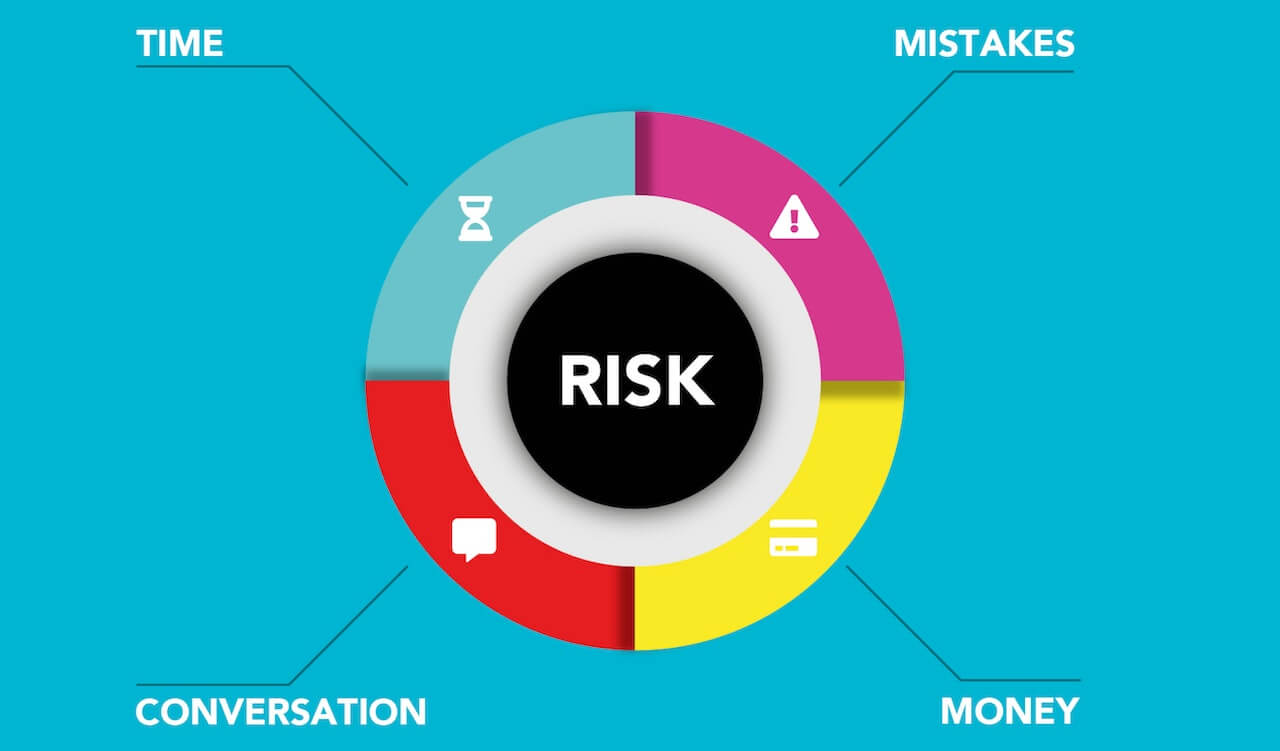Risks are an inherent phenomenon in life. They represent uncertainties that can come up and affect the course of one’s life.
Using driving as an example, even if you drive carefully and follow all the rules, there is no guarantee that an accident will not occur as a result of a bad road. Or another driver who on the other hand does not drive carefully.
Like in life, there are uncertainties when it comes to projects that can affect the outcome of the project. These are the risks in project management and they need to be managed to increase the likelihood of project success.
Project risks can come in various forms and can include risks to the project budget leading to overruns, project scope leading to scope creep, and project schedule leading to delays.
There are other risks associated with the project team members and external risks such as natural factors, regulatory requirements, and changes in the market conditions.
Project risk management is key when it comes to ensuring the success of your project and as a project manager, you need to be very proactive when it comes to managing project risks.
In this article, we will focus on the concept of risks in project management, categories of risks, major types of risks, and how to prevent and manage these project risks.
What are the Risks in Project Management?
Project risks are events that may or may not occur that can affect your project positively or negatively. These events can be related to the project processes, people, technology, or resources.
While these events may not actually occur, it is important to recognize that they are out there and to be able to identify them and prepare adequately for the possibility of occurrence and their effect on the outcome of your project.
Note that while most people immediately assume a negative occurrence when they hear the word risk, there are also unexpected events that may occur that have a positive spin on the project outcome.
To increase the likelihood of project success, positive and negative risks should be identified and managed properly.

Difference Between Project Risks and Issues
It is essential to clarify the distinction between project risks and issues as they are often erroneously used interchangeably. While both of them can affect the project outcome, they are not exactly the same thing.
Project risks are events that have the possibility of occurring although you have no idea if they actually will happen or when.
Issues on the other hand are things that you know for certain you will have to deal with and probably have an idea of when they are going to happen.

Elements of Risks in Project Management
These are some elements to consider when it comes to risks in project management.
1. Risk Event
The risk event refers to what may happen that can affect the project. These events have the possibility of occurring and will affect the project outcome positively or negatively if they do.
2. Risk Timeframe
The risk timeframe gives an idea of when a risk event is likely to occur. It could be within a year which is regarded as short-term, within 1 to 3 years which is medium-term, or more than 3 years which is long-term.
3. Risk Probability
Another element to consider is the possibility of this event actually occurring. The risk probability is the likelihood of a risk event happening.
4. Risk Impact
The risk impact of an event is a representation of the outcome of the occurrence of a risk event in a project. It is concerned with to what extent the project outcome is affected if the event actually occurs.
5. Risk Factors
The risk factors center around the events that may trigger or lead to the occurrence of a risk event. Understanding these is the key to staying proactive and planning for these uncertainties.

6. Risk Appetite
Risk appetite is the level of risk that is acceptable to an individual or organization. There is a high-risk appetite, as well as a low-risk appetite.
7. Risk Threshold
This is the specific point at which a risk becomes unacceptable and action has to be taken on it.
Risk Categories in Project Management
Risk in its simplest form can be defined as uncertainty. While there are several risks that can occur during the project life cycle, these risks can be categorized into 4 distinct types or categories.
Categorizing the risks of a project helps you to separate the project risks into different groups for evaluation and planning of adequate responses.
While there are different ways of doing this depending on the industry, organization, and project manager, the method used should be included in the project risk management plan.
Risks can be categorized into project-level risks and business-level risks, and these can be further broken into subcategories.
According to the Project Management Institute (PMI), project risks can be categorized into operational, short-term strategic, and long-term strategic risks.
1. Operational Risks
Operational risks refer to uncertainties that may affect the project’s operational goals and objectives. This essentially relates to the project’s end result which is the product or service.
They are risks that can affect the effectiveness of the end result or deliverable of the project.
2. Short-term Strategic Risks
Short-term strategic project risks are uncertainties that can affect the project’s expected outcome. These risks can impact the short-term results expected from the project deliverable.
3. Long-term Strategic Risks
Long-term strategic project risks are uncertainties that can affect the project’s long-term strategic goals that the project is being executed to meet or achieve.

Positive Risks in Project Management
Contrary to popular belief, the word risk does not necessarily always infer a bad thing or a problem. Some risks can actually help the company and these are termed positive risks.
Positive risks are unplanned events with a possibility of occurrence that can help improve the project’s likelihood of success.
When identifying risks, it is best practice for positive risks that are identified to be exploited as best as possible to reap the potential benefits.

Negative Risks in Project Management
Negative risks are those risks that come to mind when you think of risks. They are events that have the possibility of occurring and will harm the chances of the success of the project if they happen.
These risks are to be identified and proactive measures should be put in place to ensure they do not hinder the project’s success.

Common Types of Risks in Project Management
When managing and executing a project, there is a myriad of risks that can come up. To put it succinctly, anything can happen.
However, there are some major types of risks that you need to be on the lookout for as they happen to be quite common in projects.
1. Communication Risk
One of the major causes of issues in a project comes from gaps in communication. Communication is key to a successful project and it is estimated that as a project manager you spend up to 80% of your time on communication.
A project is at risk of failure when there is a lack of clarity, and this often stems from a lack of proper communication.
2. Schedule Risk
The project schedule is a major constraint as clients and stakeholders expect projects to be delivered within a stipulated time.
Schedule risks relate to the project schedule and can lead to delays and time overruns in delivering the project.
These risks often arise from factors like unexpected changes in project scope or requirements, delays in completing certain tasks, or dependencies from other teams.
3. Cost Risk
Cost risks are events that can result in a project exceeding the allocated budget. These events may be a result of unexpected changes in project costs such as labor costs or rates of materials.
4. Quality Risk
Quality risks relate to events that may occur and affect the quality of the project and its deliverable or end product. It is concerned with the quality of the final product with regard to compliance with standards.
These risks can arise from poor communication among team members, unclear project requirements, inadequate quality assurance and control processes, or unclear project specifications and standards.
5. Resource Risk
Resources risks in project management are events that can affect the likelihood of the project’s success due to a lack of adequate resources required to execute the project successfully.
This can be a result of unexpected unavailability of key team members, difficulty in obtaining vital materials and supplies, or a lack of qualified skilled personnel required for the project.
6. Scope Risk
Scope risks are events that can affect the likelihood of the project meeting its scope and the project goals and objectives by extension.
These risks can arise as a result of additions to the project scope and requirements which can lead to scope creep. It can also be a result of changes in the project objectives and customer requirements.
Also Read: Top 5 Ways to Avoid Gold Plaiting in Project Management
7. Technical Risk
Technical risks in project management are risks that are related to the technical aspects of a project. These include compatibility issues and design flaws.
These risks can have various negative effects on the project and the final product or deliverable such as low quality, increased costs, and delays.
8. Operational Risk
Operational risks are potential problems that can arise during the project execution and significantly impact the project’s success.
These risks may arise due to various reasons including changes in business processes, inadequate communication, and unforeseen circumstances.
9. Political Risk
Political risks are events arising from political factors that can affect the success of a project. These events include changes in government policies, political climate shifts, and changes in regulations.
10. Market Risk
Market risks are events related to market conditions that can impact project processes and outcomes. Some of these events are shifts in consumer demand, and changes in resource availability.
11. Financial Risk
Financial risks have to do with the budget and financial performance of the project.
While finance is related to costs, this risk is more focused on getting the finances required for the project and the risk of failure of the project due to an inability to get adequate financing.
12. Legal Risk
Legal risks are risks that are related to legal issues that can impact the project. These include risks associated with contracts, and compliance with the law and regulations.

How to Prevent and Manage Risks in Project Management
Risks are inevitable in project management and there will always be risks that impact your project. The key to ensuring your project is successful despite these risks is to successfully manage them.
Here are some steps useful for the management of project risks that can help increase the chances of a successful project.
1. Identification of Potential Risks
The first step to dealing with and managing risks in project management is to identify these risks. This can be done by a risk assessment with the purpose of identifying any potential risks to the project, and the likelihood and impact of each of these identified risks.
This will give a risk register that is updated and used throughout the project for managing the project risks. Using risk registers of previous similar projects is a good way to start the identification of project risks.
2. Analysis and Prioritization of Identified Project Risks
When potential risks to the project have been identified, they need to be analyzed and prioritized according to their likelihood of occurrence and potential impact on the project.
This is essential as some risks are more likely to occur than others, and some if they do occur have a far greater impact on the project.
To manage these risks properly, priority has to be on those that are a greater risk to the project and risk analysis is key to determining those that fall into this category.
3. Develop a Risk Management Plan
After identifying and prioritizing the project risks, the next thing to do is to develop a plan on how to manage these risks.
The risk management plan is to detail how to recognize triggers for the risks, and plan the various responses to these risks to avoid, mitigate, transfer, or accept the risks if they do occur.
4. Implement the Risk Management Plan
No matter how good a plan is, its effectiveness lies in its implementation. This involves consistently following the steps of the risk management plan and consistently checking the effectiveness of the plan.
5. Monitor and Control the Project Risks
Throughout the duration of the project, as a project manager, you have to constantly monitor and control the project risks along with your project team.
This involves constantly updating the risk register and the risk management plan as the project progresses, and new insights are uncovered.

Also Read: Success Criteria and Kill Point in Project Management
Conclusion
Since risks are inevitable in projects, the most logical thing to know is fully understand the categories and common types of risks that can impact your project, and actively working on managing them.
Following the steps for dealing with and managing project risks will help in increasing the likelihood of project success and getting the desired business value.






Bel post, l’ho condiviso con i miei amici.
Grazie
nyc notes
Thank you.